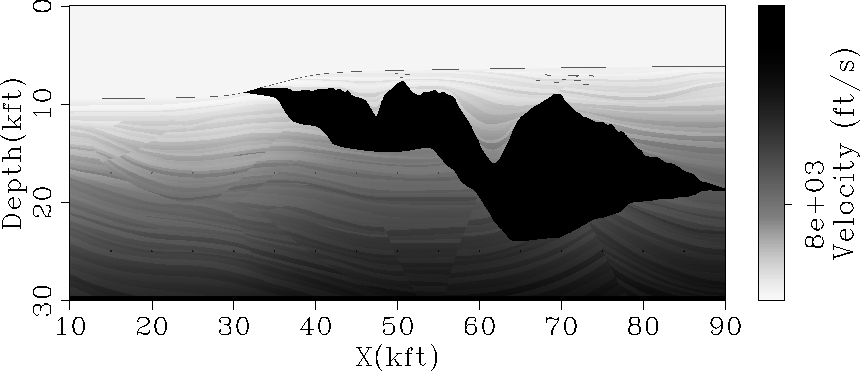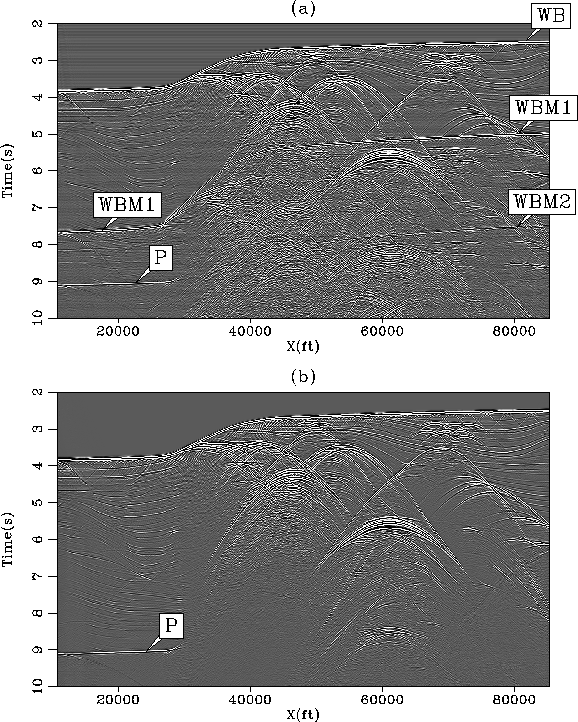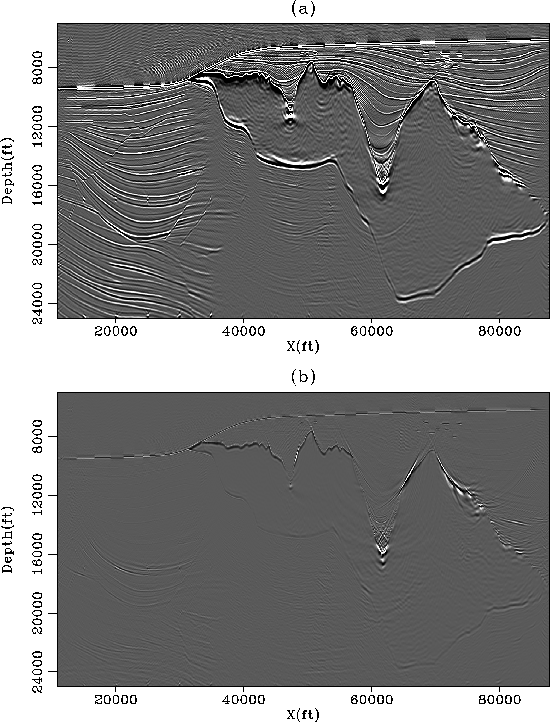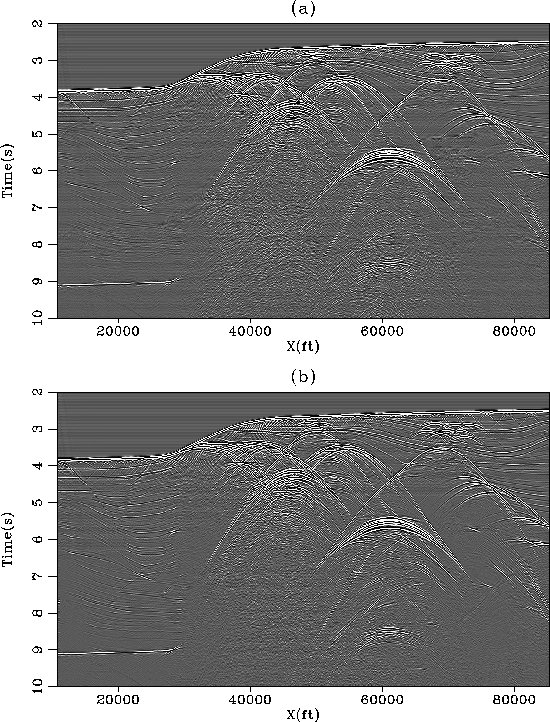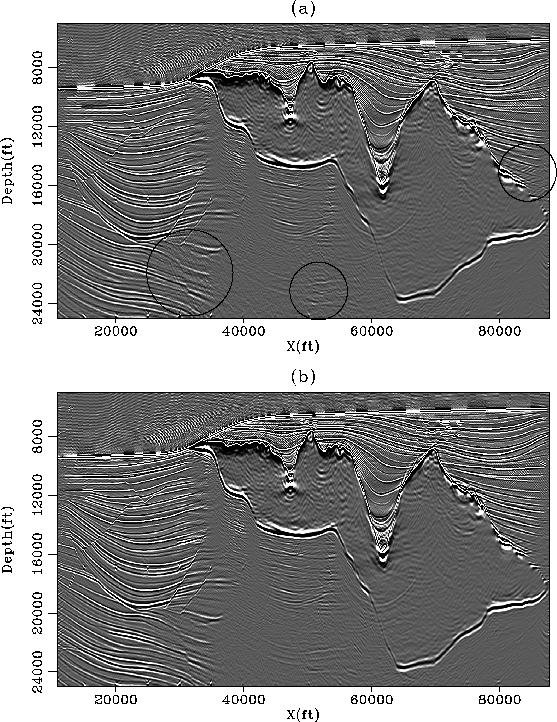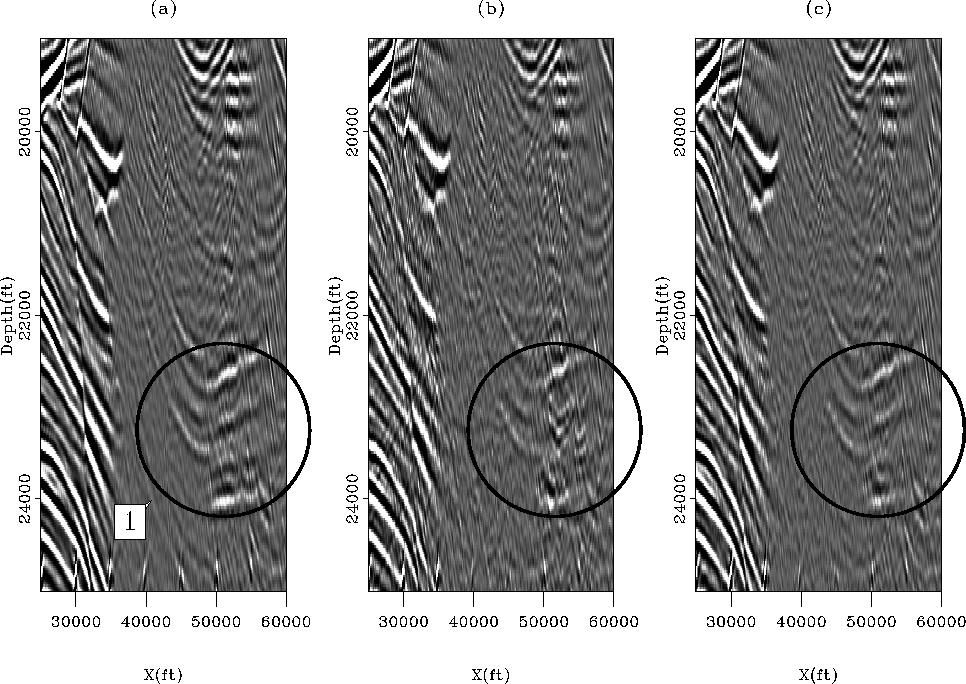




Next: Adaptive vs. Pattern based
Up: Multiple attenuation with the
Previous: Estimating biases
Now I assume that only a model of the multiples is known.
The Spitz approximation in equation (![[*]](http://sepwww.stanford.edu/latex2html/cross_ref_motif.gif) )
shows how the PEFs for the signal can be estimated.
The primaries are recovered with 2-D and 3-D filters. Figure
)
shows how the PEFs for the signal can be estimated.
The primaries are recovered with 2-D and 3-D filters. Figure
![[*]](http://sepwww.stanford.edu/latex2html/cross_ref_motif.gif) displays two constant offset sections after
multiple attenuation with 2-D and 3-D PEFs. 3-D PEFs give by far the best
results and attenuate multiples very well.
displays two constant offset sections after
multiple attenuation with 2-D and 3-D PEFs. 3-D PEFs give by far the best
results and attenuate multiples very well.
After migration, we see again in Figure ![[*]](http://sepwww.stanford.edu/latex2html/cross_ref_motif.gif) that the 3-D PEFs
attenuate the multiples more effectively. The circles in Figure
that the 3-D PEFs
attenuate the multiples more effectively. The circles in Figure
![[*]](http://sepwww.stanford.edu/latex2html/cross_ref_motif.gif) surround areas where the 3-D filters
are the most effective. A close-up in Figure
surround areas where the 3-D filters
are the most effective. A close-up in Figure
![[*]](http://sepwww.stanford.edu/latex2html/cross_ref_motif.gif) demonstrates in more detail
(e.g., within the circles) how
the two results with 2-D or 3-D filters differ below the salt. Events are
more continuous and preserved better with 3-D filters. Comparing with
the true reflectors in Figure
demonstrates in more detail
(e.g., within the circles) how
the two results with 2-D or 3-D filters differ below the salt. Events are
more continuous and preserved better with 3-D filters. Comparing with
the true reflectors in Figure ![[*]](http://sepwww.stanford.edu/latex2html/cross_ref_motif.gif) a,
important primaries (shown at '1' in Figure
a,
important primaries (shown at '1' in Figure
![[*]](http://sepwww.stanford.edu/latex2html/cross_ref_motif.gif) a)
are attenuated with both 2-D and 3-D filters.
a)
are attenuated with both 2-D and 3-D filters.
These important observations could not have been made before migration
in the prestack domain because the primaries are much weaker than the
surface-related multiples below the salt. This illustrates
that for complex geology, the quality of a multiple removal technique
should be assessed in the image space as often as possible.
The fact that some primaries are attenuated in Figure
![[*]](http://sepwww.stanford.edu/latex2html/cross_ref_motif.gif) should
motivate us in devising improved strategies for building more accurate
noise and signal models.
should
motivate us in devising improved strategies for building more accurate
noise and signal models.
The fact that 3-D PEFs attenuate the multiples better than 2-D PEFs
is not surprising. With higher dimensions, primaries and multiples are
less likely to be correlated. Therefore, the noise and signal PEFs are less prone to
annihilate similar data components. This is particularly important with
the Spitz approximation which implicitly assumes that primaries and
multiples are uncorrelated.
The next section compares the pattern-based approach with adaptive
subtraction on a synthetic dataset provided by BP.
stratigraphy
Figure 2 Stratigraphic interval velocity model of the Sigsbee2B
dataset.




 datasignal
datasignal
Figure 3 Two constant offset sections (h=1125 ft)
of the Sigsbee2B dataset with (a) and without (b) free surface
condition. The multiples are very strong below 5 s. The weak horizontal
striping in (a) comes from a source effect only present with the
free surface condition modeling. Arrow WB shows the water-bottom
reflection, WBM1 the first order surface-related multiple for the
water-bottom, WBM2 the second order surface-related multiple for the
water-bottom, and P a strong primary.




 datasignal-mig
datasignal-mig
Figure 4 Migrated images at zero-offset for
the data with (a) and without (b) free surface condition. Comparing with
Figure ![[*]](http://sepwww.stanford.edu/latex2html/cross_ref_motif.gif) , the multiples appear much weaker below
the salt after migration. However, some reflectors near 22 kft are
hidden in (a). Arrow WBM1 shows the first order water-bottom
multiple after migration. Arrow N shows some noise associated with
the migration of multiples beneath the salt body.
, the multiples appear much weaker below
the salt after migration. However, some reflectors near 22 kft are
hidden in (a). Arrow WBM1 shows the first order water-bottom
multiple after migration. Arrow N shows some noise associated with
the migration of multiples beneath the salt body.




 signal-true
signal-true
Figure 5 Two constant offset panels at h=1125
ft. for (a) the estimated primaries and (b) the difference with the true
primaries. The true primaries and multiples are used to estimate
the PEFs. Arrow P shows a primary that could be mistaken for a multiple.




 signal-true-mig
signal-true-mig
Figure 6 (a) Migration result after multiple
attenuation when the true primaries and multiples are used to estimate
the PEFs. (b) Difference between (a) and Figure
![[*]](http://sepwww.stanford.edu/latex2html/cross_ref_motif.gif) b. The estimated primaries are almost exact.
b. The estimated primaries are almost exact.




 signal-2D-3D-PEF
signal-2D-3D-PEF
Figure 7 Two constant offset sections
(h=1125 ft) after multiple attenuation with the Spitz
approximation using (a) 2-D and (b) 3-D filters.




 signal-2D-3D-PEF-mig
signal-2D-3D-PEF-mig
Figure 8 Two migration results of the
estimated primaries with (a) 2-D and (b) 3-D filters. The circles show
areas where multiples are better attenuated with 3-D filters than
with 2-D filters.




 signal-2D-3D-PEF-small-mig
signal-2D-3D-PEF-small-mig
Figure 9 Close-up of Figure
![[*]](http://sepwww.stanford.edu/latex2html/cross_ref_motif.gif) showing two migrated images when
(b) 2-D and (c) 3-D filters are used. The true primaries are shown in
(a). Arrow '1' points to primaries that are attenuated with the
pattern-based approach. The circles show an area where the 3-D filters
are the most effective at removing the multiples.
showing two migrated images when
(b) 2-D and (c) 3-D filters are used. The true primaries are shown in
(a). Arrow '1' points to primaries that are attenuated with the
pattern-based approach. The circles show an area where the 3-D filters
are the most effective at removing the multiples.










Next: Adaptive vs. Pattern based
Up: Multiple attenuation with the
Previous: Estimating biases
Stanford Exploration Project
5/5/2005
![[*]](http://sepwww.stanford.edu/latex2html/cross_ref_motif.gif) that the 3-D PEFs
attenuate the multiples more effectively. The circles in Figure
that the 3-D PEFs
attenuate the multiples more effectively. The circles in Figure
![[*]](http://sepwww.stanford.edu/latex2html/cross_ref_motif.gif) surround areas where the 3-D filters
are the most effective. A close-up in Figure
surround areas where the 3-D filters
are the most effective. A close-up in Figure
![[*]](http://sepwww.stanford.edu/latex2html/cross_ref_motif.gif) demonstrates in more detail
(e.g., within the circles) how
the two results with 2-D or 3-D filters differ below the salt. Events are
more continuous and preserved better with 3-D filters. Comparing with
the true reflectors in Figure
demonstrates in more detail
(e.g., within the circles) how
the two results with 2-D or 3-D filters differ below the salt. Events are
more continuous and preserved better with 3-D filters. Comparing with
the true reflectors in Figure ![[*]](http://sepwww.stanford.edu/latex2html/cross_ref_motif.gif) a,
important primaries (shown at '1' in Figure
a,
important primaries (shown at '1' in Figure
![[*]](http://sepwww.stanford.edu/latex2html/cross_ref_motif.gif) a)
are attenuated with both 2-D and 3-D filters.
a)
are attenuated with both 2-D and 3-D filters.
